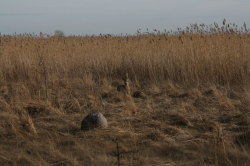Ruhnu fauna 



The sea and the seclusion of the island have played an important role in the development of fauna on Ruhnu. Insects are the most thoroughly researched invertebrates on the island (more than 1,000 species have been identified). 157 species of summer spiders have been identified (1988).
In 1934, 14 species of mollusks were found on Ruhnu, in the beginning of the 1970s, 5 specimens of Burgundy snails were taken to the island and those have now reproduced in great numbers, there are also a lot of Limax. The once common medicinal leeches (Hirudo medicinalis) disappeared from the island in the beginning of the 19th century.
All groups of vertebrates are represented on Ruhnu. The fish here are all common species in the Gulf of Riga, they include eel, Baltic herring, sprat, salmon, brown trout, smelt, crucian carp, zander, viviparous eelpout, shorthorn sculpin, fourhorn scuplin, perch and flounder. Gretagrung Shoal is the most important spawning area for Coregonus lavaretus in Estonia. Amphibians and reptiles are represented on Ruhnu by smooth newt (III conservation class), common frog (III conservation class), natterjack toad (I conservation class) and grass snake (III conservation class). The natterjack toad population that was still very numerous on the island in the 1980s has now almost faded away mostly due to its habitats having being destroyed. According to K. Peterson (1993), there have been 183 species of birds on the island of which 108 species are nesting birds according to the Estonian Atlas of Birds (1993). Mammals are represented by northern bat (Eptesicus nilssonii; II conservation class), red fox, roe deer (introduced in the beginning of the 1970s), house mouse (Mus musculus) and brown rat on land, and by grey (III conservation class) and ringed seals (II conservation class) in the sea. Hedgehogs also lived on the island for a while as an introduced species. Occasionally, hares, wolves and lynxes have wondered to the island over sea ice in the winter. The brown bear who visited Ruhnu in 2006 has not been the only one.
Created in 2014




